Pathophysiology and Pharmacology of a 94-year-old Female Patient: A Case Study
VerifiedAdded on 2023/06/04
|12
|3730
|301
AI Summary
This case study discusses the pathophysiological and pharmacological changes in relation to a 94-year-old female patient's healthcare. It also provides recommendations for drafting a person-centred care plan for the patient.
Contribute Materials
Your contribution can guide someone’s learning journey. Share your
documents today.
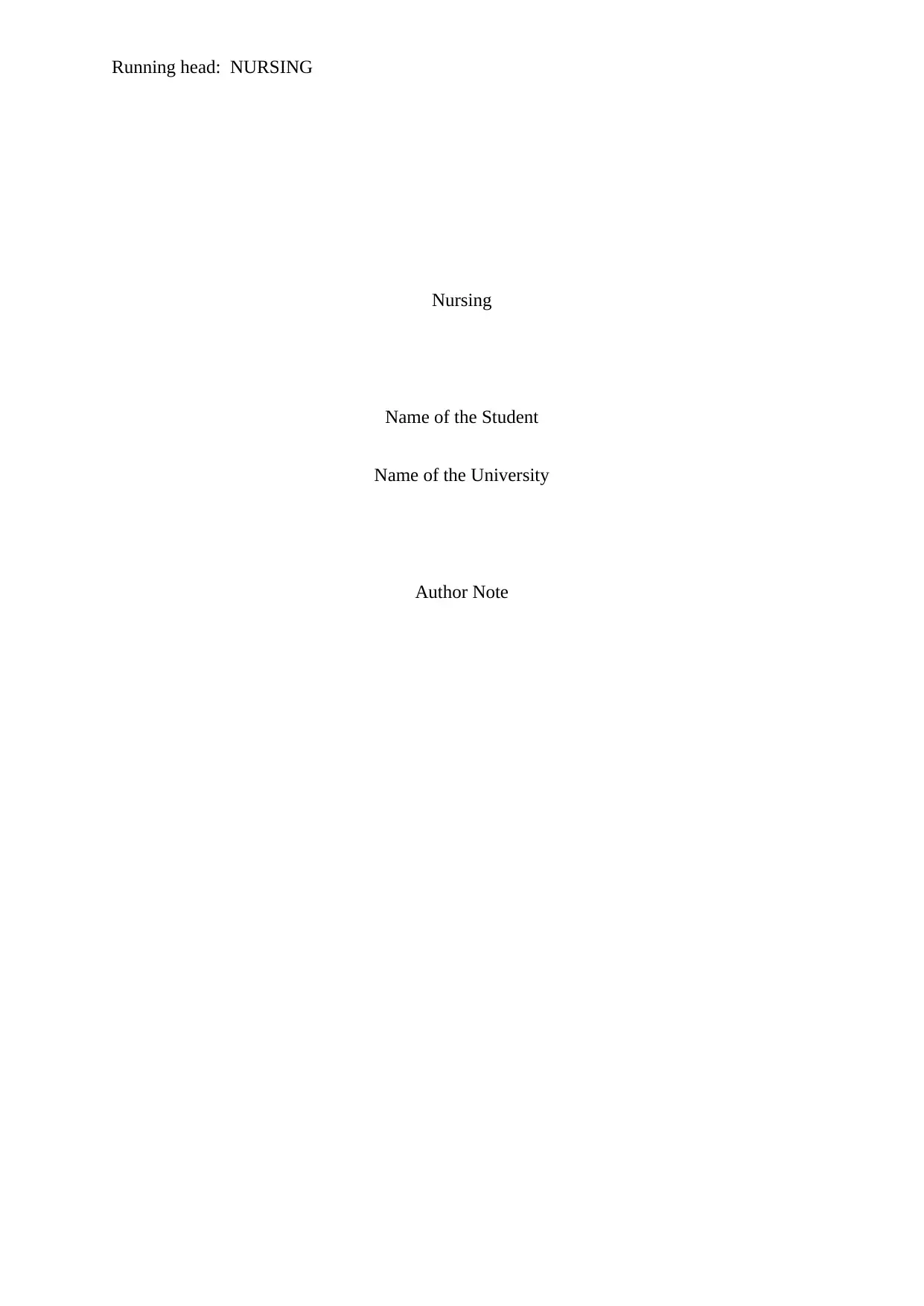
Running head: NURSING
Nursing
Name of the Student
Name of the University
Author Note
Nursing
Name of the Student
Name of the University
Author Note
Secure Best Marks with AI Grader
Need help grading? Try our AI Grader for instant feedback on your assignments.
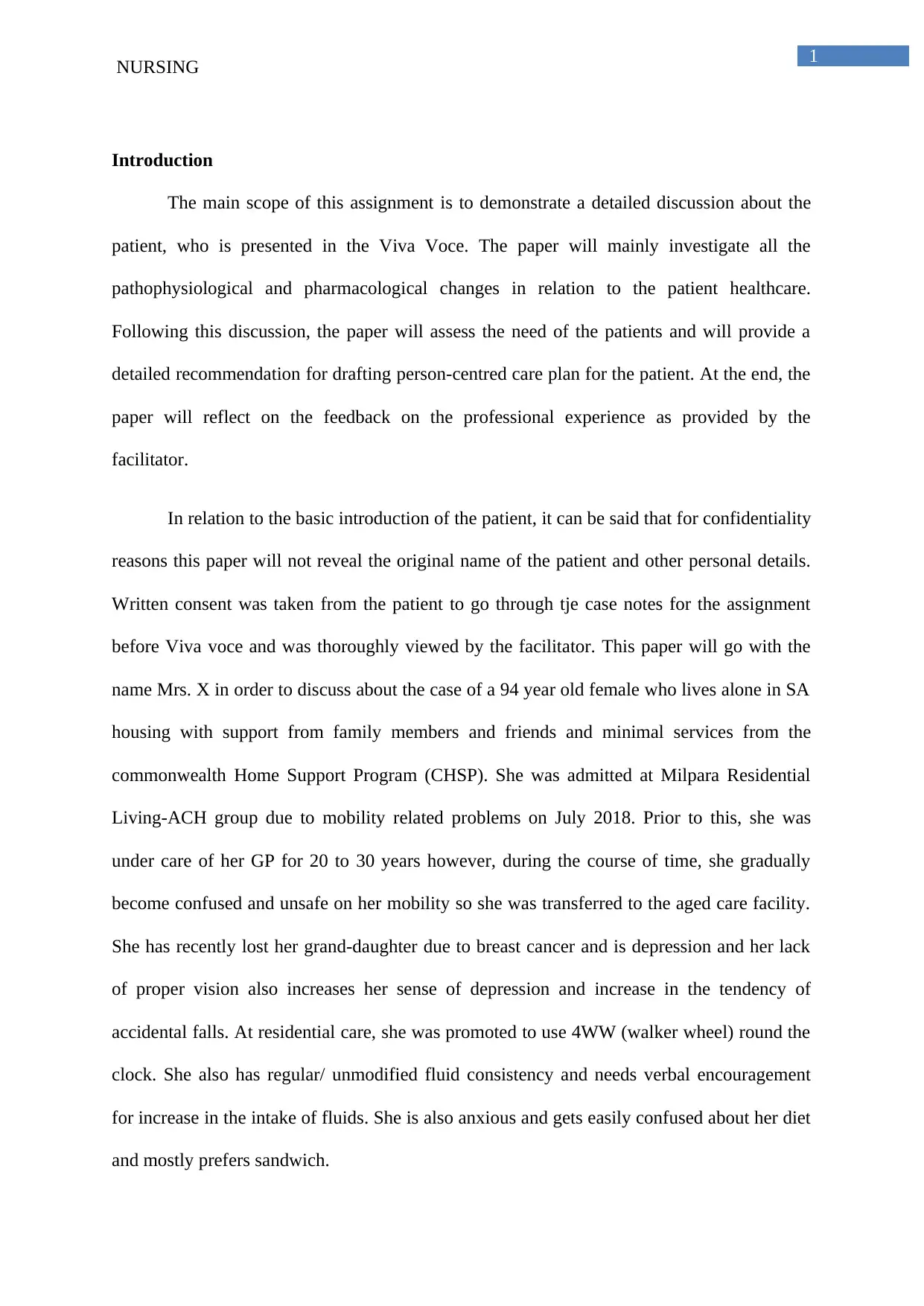
1
NURSING
Introduction
The main scope of this assignment is to demonstrate a detailed discussion about the
patient, who is presented in the Viva Voce. The paper will mainly investigate all the
pathophysiological and pharmacological changes in relation to the patient healthcare.
Following this discussion, the paper will assess the need of the patients and will provide a
detailed recommendation for drafting person-centred care plan for the patient. At the end, the
paper will reflect on the feedback on the professional experience as provided by the
facilitator.
In relation to the basic introduction of the patient, it can be said that for confidentiality
reasons this paper will not reveal the original name of the patient and other personal details.
Written consent was taken from the patient to go through tje case notes for the assignment
before Viva voce and was thoroughly viewed by the facilitator. This paper will go with the
name Mrs. X in order to discuss about the case of a 94 year old female who lives alone in SA
housing with support from family members and friends and minimal services from the
commonwealth Home Support Program (CHSP). She was admitted at Milpara Residential
Living-ACH group due to mobility related problems on July 2018. Prior to this, she was
under care of her GP for 20 to 30 years however, during the course of time, she gradually
become confused and unsafe on her mobility so she was transferred to the aged care facility.
She has recently lost her grand-daughter due to breast cancer and is depression and her lack
of proper vision also increases her sense of depression and increase in the tendency of
accidental falls. At residential care, she was promoted to use 4WW (walker wheel) round the
clock. She also has regular/ unmodified fluid consistency and needs verbal encouragement
for increase in the intake of fluids. She is also anxious and gets easily confused about her diet
and mostly prefers sandwich.
NURSING
Introduction
The main scope of this assignment is to demonstrate a detailed discussion about the
patient, who is presented in the Viva Voce. The paper will mainly investigate all the
pathophysiological and pharmacological changes in relation to the patient healthcare.
Following this discussion, the paper will assess the need of the patients and will provide a
detailed recommendation for drafting person-centred care plan for the patient. At the end, the
paper will reflect on the feedback on the professional experience as provided by the
facilitator.
In relation to the basic introduction of the patient, it can be said that for confidentiality
reasons this paper will not reveal the original name of the patient and other personal details.
Written consent was taken from the patient to go through tje case notes for the assignment
before Viva voce and was thoroughly viewed by the facilitator. This paper will go with the
name Mrs. X in order to discuss about the case of a 94 year old female who lives alone in SA
housing with support from family members and friends and minimal services from the
commonwealth Home Support Program (CHSP). She was admitted at Milpara Residential
Living-ACH group due to mobility related problems on July 2018. Prior to this, she was
under care of her GP for 20 to 30 years however, during the course of time, she gradually
become confused and unsafe on her mobility so she was transferred to the aged care facility.
She has recently lost her grand-daughter due to breast cancer and is depression and her lack
of proper vision also increases her sense of depression and increase in the tendency of
accidental falls. At residential care, she was promoted to use 4WW (walker wheel) round the
clock. She also has regular/ unmodified fluid consistency and needs verbal encouragement
for increase in the intake of fluids. She is also anxious and gets easily confused about her diet
and mostly prefers sandwich.

2
NURSING
According to her daughter, she has frequent loss of memory and has sleep anpea,
diabetes along with low potassium level of the body. Her past medical history also included
hypertension, hyperlipidaemia, atrial fibrillation and vitamin B12 deficiency and Glaucoma.
Her current medications include Alprazolam, Amlodipine, Pantroprazole, Karvezide, Eliuis
and Atorvastin along with Duro-K Slow release tablets. The future discussion about the
pathophysiology and pharmacological changes leading to her admission is discussed below.
Pathophysiology/ Pharmacology
The primary concern is increased in the tendency of the accidental fall. The main
underlying factor behind increase in her tendency to accidental fall is her age. According to
Ambrose, Paul and Hausdorff (2013), people who are above 65 years of age have increased
tendency of accidental fall due to slippage of loss of body balance. Mrs. X is 94 years also
and according to the narration highlighted in the case study, Mrs. X has unsteady gait and has
difficulty in rising from the seated position and recurrent falls at homes. Ambrose, Paul and
Hausdorff (2013) highlighted that major risk factors, which are identified behind the
increased tendency of fall among the older adults include gait, polypharmacy and previous
history of accidental fall. Other risk factors include advancing age, visual impairments,
vfemale gender, cognitive decline in attention and executive dysfunction. After age of 40
years there occurs menopause in women, this further hampers the bone health and increases
the tendency of developing osteoporosis. Menopause or perimenopause decreases the
secretion of estrogen and this cause loss in the bone mass and bone fragility (Manolagas,
O'brien and Almeida 2013). Mrs. X also has dementia and this demented condition is another
reason behind her increased in the tendency of fall. According to Jansen et al. (2015),
dementia is a symptom of a variety of specific structural brain disease, which leads to the
NURSING
According to her daughter, she has frequent loss of memory and has sleep anpea,
diabetes along with low potassium level of the body. Her past medical history also included
hypertension, hyperlipidaemia, atrial fibrillation and vitamin B12 deficiency and Glaucoma.
Her current medications include Alprazolam, Amlodipine, Pantroprazole, Karvezide, Eliuis
and Atorvastin along with Duro-K Slow release tablets. The future discussion about the
pathophysiology and pharmacological changes leading to her admission is discussed below.
Pathophysiology/ Pharmacology
The primary concern is increased in the tendency of the accidental fall. The main
underlying factor behind increase in her tendency to accidental fall is her age. According to
Ambrose, Paul and Hausdorff (2013), people who are above 65 years of age have increased
tendency of accidental fall due to slippage of loss of body balance. Mrs. X is 94 years also
and according to the narration highlighted in the case study, Mrs. X has unsteady gait and has
difficulty in rising from the seated position and recurrent falls at homes. Ambrose, Paul and
Hausdorff (2013) highlighted that major risk factors, which are identified behind the
increased tendency of fall among the older adults include gait, polypharmacy and previous
history of accidental fall. Other risk factors include advancing age, visual impairments,
vfemale gender, cognitive decline in attention and executive dysfunction. After age of 40
years there occurs menopause in women, this further hampers the bone health and increases
the tendency of developing osteoporosis. Menopause or perimenopause decreases the
secretion of estrogen and this cause loss in the bone mass and bone fragility (Manolagas,
O'brien and Almeida 2013). Mrs. X also has dementia and this demented condition is another
reason behind her increased in the tendency of fall. According to Jansen et al. (2015),
dementia is a symptom of a variety of specific structural brain disease, which leads to the
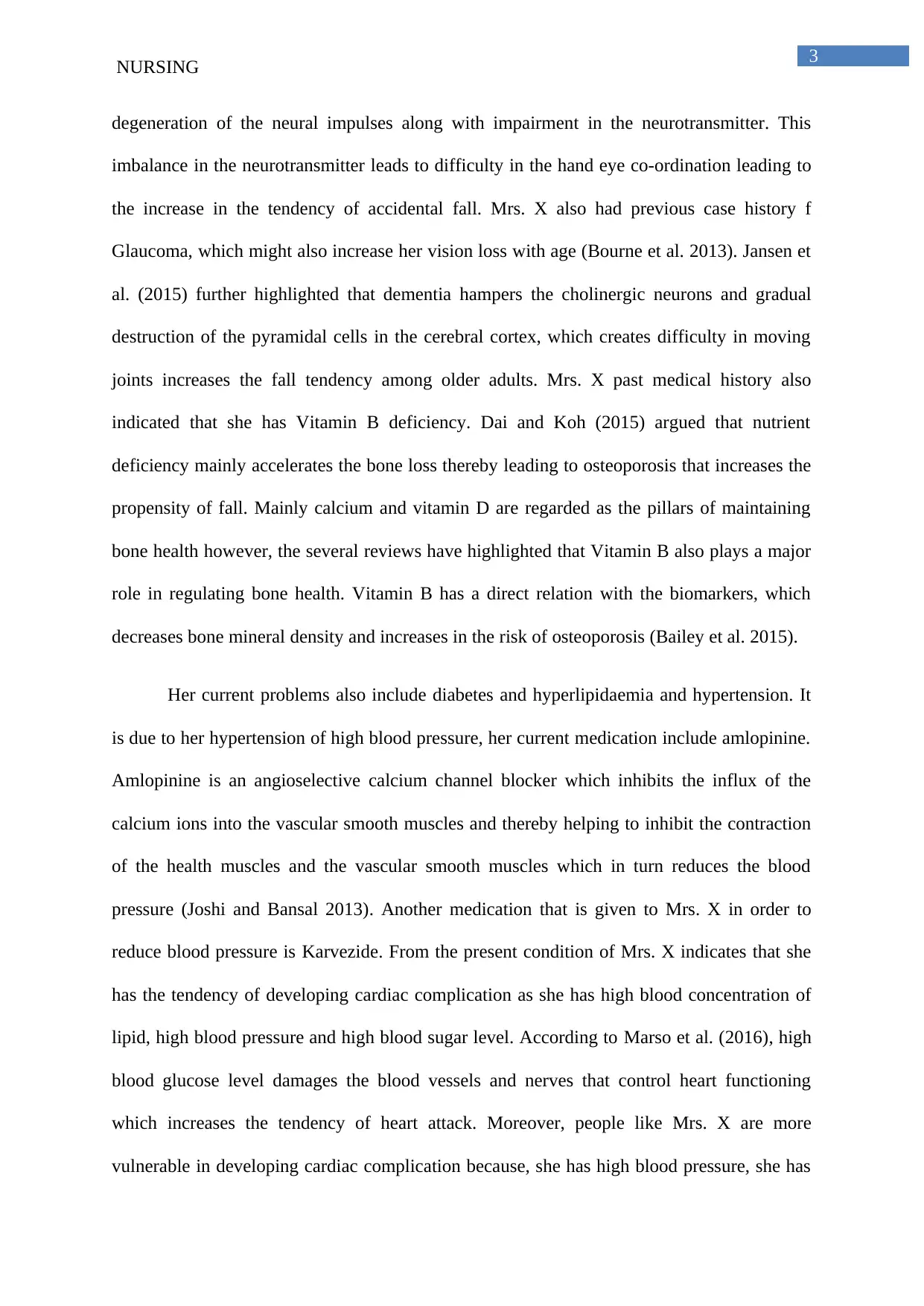
3
NURSING
degeneration of the neural impulses along with impairment in the neurotransmitter. This
imbalance in the neurotransmitter leads to difficulty in the hand eye co-ordination leading to
the increase in the tendency of accidental fall. Mrs. X also had previous case history f
Glaucoma, which might also increase her vision loss with age (Bourne et al. 2013). Jansen et
al. (2015) further highlighted that dementia hampers the cholinergic neurons and gradual
destruction of the pyramidal cells in the cerebral cortex, which creates difficulty in moving
joints increases the fall tendency among older adults. Mrs. X past medical history also
indicated that she has Vitamin B deficiency. Dai and Koh (2015) argued that nutrient
deficiency mainly accelerates the bone loss thereby leading to osteoporosis that increases the
propensity of fall. Mainly calcium and vitamin D are regarded as the pillars of maintaining
bone health however, the several reviews have highlighted that Vitamin B also plays a major
role in regulating bone health. Vitamin B has a direct relation with the biomarkers, which
decreases bone mineral density and increases in the risk of osteoporosis (Bailey et al. 2015).
Her current problems also include diabetes and hyperlipidaemia and hypertension. It
is due to her hypertension of high blood pressure, her current medication include amlopinine.
Amlopinine is an angioselective calcium channel blocker which inhibits the influx of the
calcium ions into the vascular smooth muscles and thereby helping to inhibit the contraction
of the health muscles and the vascular smooth muscles which in turn reduces the blood
pressure (Joshi and Bansal 2013). Another medication that is given to Mrs. X in order to
reduce blood pressure is Karvezide. From the present condition of Mrs. X indicates that she
has the tendency of developing cardiac complication as she has high blood concentration of
lipid, high blood pressure and high blood sugar level. According to Marso et al. (2016), high
blood glucose level damages the blood vessels and nerves that control heart functioning
which increases the tendency of heart attack. Moreover, people like Mrs. X are more
vulnerable in developing cardiac complication because, she has high blood pressure, she has
NURSING
degeneration of the neural impulses along with impairment in the neurotransmitter. This
imbalance in the neurotransmitter leads to difficulty in the hand eye co-ordination leading to
the increase in the tendency of accidental fall. Mrs. X also had previous case history f
Glaucoma, which might also increase her vision loss with age (Bourne et al. 2013). Jansen et
al. (2015) further highlighted that dementia hampers the cholinergic neurons and gradual
destruction of the pyramidal cells in the cerebral cortex, which creates difficulty in moving
joints increases the fall tendency among older adults. Mrs. X past medical history also
indicated that she has Vitamin B deficiency. Dai and Koh (2015) argued that nutrient
deficiency mainly accelerates the bone loss thereby leading to osteoporosis that increases the
propensity of fall. Mainly calcium and vitamin D are regarded as the pillars of maintaining
bone health however, the several reviews have highlighted that Vitamin B also plays a major
role in regulating bone health. Vitamin B has a direct relation with the biomarkers, which
decreases bone mineral density and increases in the risk of osteoporosis (Bailey et al. 2015).
Her current problems also include diabetes and hyperlipidaemia and hypertension. It
is due to her hypertension of high blood pressure, her current medication include amlopinine.
Amlopinine is an angioselective calcium channel blocker which inhibits the influx of the
calcium ions into the vascular smooth muscles and thereby helping to inhibit the contraction
of the health muscles and the vascular smooth muscles which in turn reduces the blood
pressure (Joshi and Bansal 2013). Another medication that is given to Mrs. X in order to
reduce blood pressure is Karvezide. From the present condition of Mrs. X indicates that she
has the tendency of developing cardiac complication as she has high blood concentration of
lipid, high blood pressure and high blood sugar level. According to Marso et al. (2016), high
blood glucose level damages the blood vessels and nerves that control heart functioning
which increases the tendency of heart attack. Moreover, people like Mrs. X are more
vulnerable in developing cardiac complication because, she has high blood pressure, she has
Secure Best Marks with AI Grader
Need help grading? Try our AI Grader for instant feedback on your assignments.
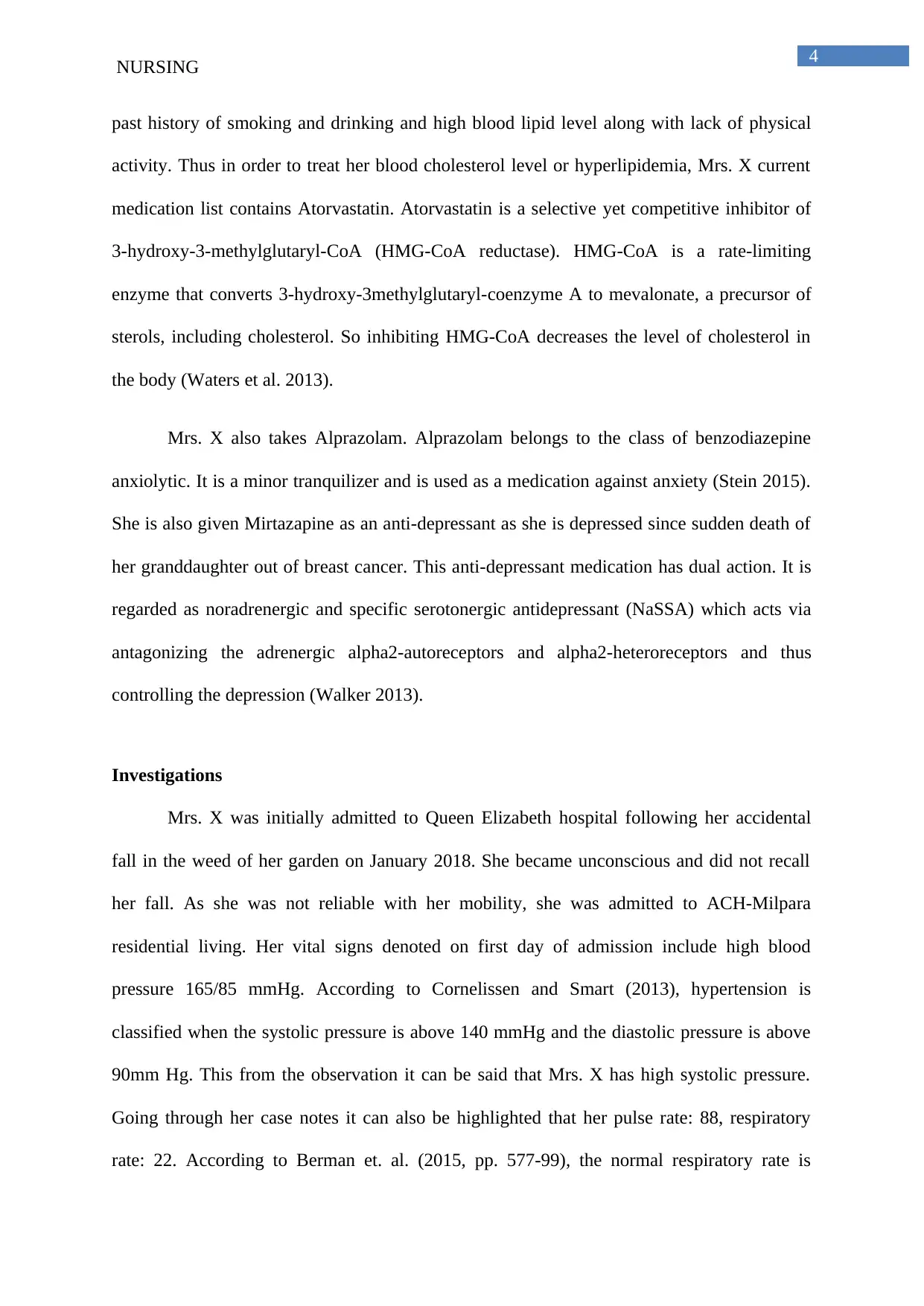
4
NURSING
past history of smoking and drinking and high blood lipid level along with lack of physical
activity. Thus in order to treat her blood cholesterol level or hyperlipidemia, Mrs. X current
medication list contains Atorvastatin. Atorvastatin is a selective yet competitive inhibitor of
3-hydroxy-3-methylglutaryl-CoA (HMG-CoA reductase). HMG-CoA is a rate-limiting
enzyme that converts 3-hydroxy-3methylglutaryl-coenzyme A to mevalonate, a precursor of
sterols, including cholesterol. So inhibiting HMG-CoA decreases the level of cholesterol in
the body (Waters et al. 2013).
Mrs. X also takes Alprazolam. Alprazolam belongs to the class of benzodiazepine
anxiolytic. It is a minor tranquilizer and is used as a medication against anxiety (Stein 2015).
She is also given Mirtazapine as an anti-depressant as she is depressed since sudden death of
her granddaughter out of breast cancer. This anti-depressant medication has dual action. It is
regarded as noradrenergic and specific serotonergic antidepressant (NaSSA) which acts via
antagonizing the adrenergic alpha2-autoreceptors and alpha2-heteroreceptors and thus
controlling the depression (Walker 2013).
Investigations
Mrs. X was initially admitted to Queen Elizabeth hospital following her accidental
fall in the weed of her garden on January 2018. She became unconscious and did not recall
her fall. As she was not reliable with her mobility, she was admitted to ACH-Milpara
residential living. Her vital signs denoted on first day of admission include high blood
pressure 165/85 mmHg. According to Cornelissen and Smart (2013), hypertension is
classified when the systolic pressure is above 140 mmHg and the diastolic pressure is above
90mm Hg. This from the observation it can be said that Mrs. X has high systolic pressure.
Going through her case notes it can also be highlighted that her pulse rate: 88, respiratory
rate: 22. According to Berman et. al. (2015, pp. 577-99), the normal respiratory rate is
NURSING
past history of smoking and drinking and high blood lipid level along with lack of physical
activity. Thus in order to treat her blood cholesterol level or hyperlipidemia, Mrs. X current
medication list contains Atorvastatin. Atorvastatin is a selective yet competitive inhibitor of
3-hydroxy-3-methylglutaryl-CoA (HMG-CoA reductase). HMG-CoA is a rate-limiting
enzyme that converts 3-hydroxy-3methylglutaryl-coenzyme A to mevalonate, a precursor of
sterols, including cholesterol. So inhibiting HMG-CoA decreases the level of cholesterol in
the body (Waters et al. 2013).
Mrs. X also takes Alprazolam. Alprazolam belongs to the class of benzodiazepine
anxiolytic. It is a minor tranquilizer and is used as a medication against anxiety (Stein 2015).
She is also given Mirtazapine as an anti-depressant as she is depressed since sudden death of
her granddaughter out of breast cancer. This anti-depressant medication has dual action. It is
regarded as noradrenergic and specific serotonergic antidepressant (NaSSA) which acts via
antagonizing the adrenergic alpha2-autoreceptors and alpha2-heteroreceptors and thus
controlling the depression (Walker 2013).
Investigations
Mrs. X was initially admitted to Queen Elizabeth hospital following her accidental
fall in the weed of her garden on January 2018. She became unconscious and did not recall
her fall. As she was not reliable with her mobility, she was admitted to ACH-Milpara
residential living. Her vital signs denoted on first day of admission include high blood
pressure 165/85 mmHg. According to Cornelissen and Smart (2013), hypertension is
classified when the systolic pressure is above 140 mmHg and the diastolic pressure is above
90mm Hg. This from the observation it can be said that Mrs. X has high systolic pressure.
Going through her case notes it can also be highlighted that her pulse rate: 88, respiratory
rate: 22. According to Berman et. al. (2015, pp. 577-99), the normal respiratory rate is
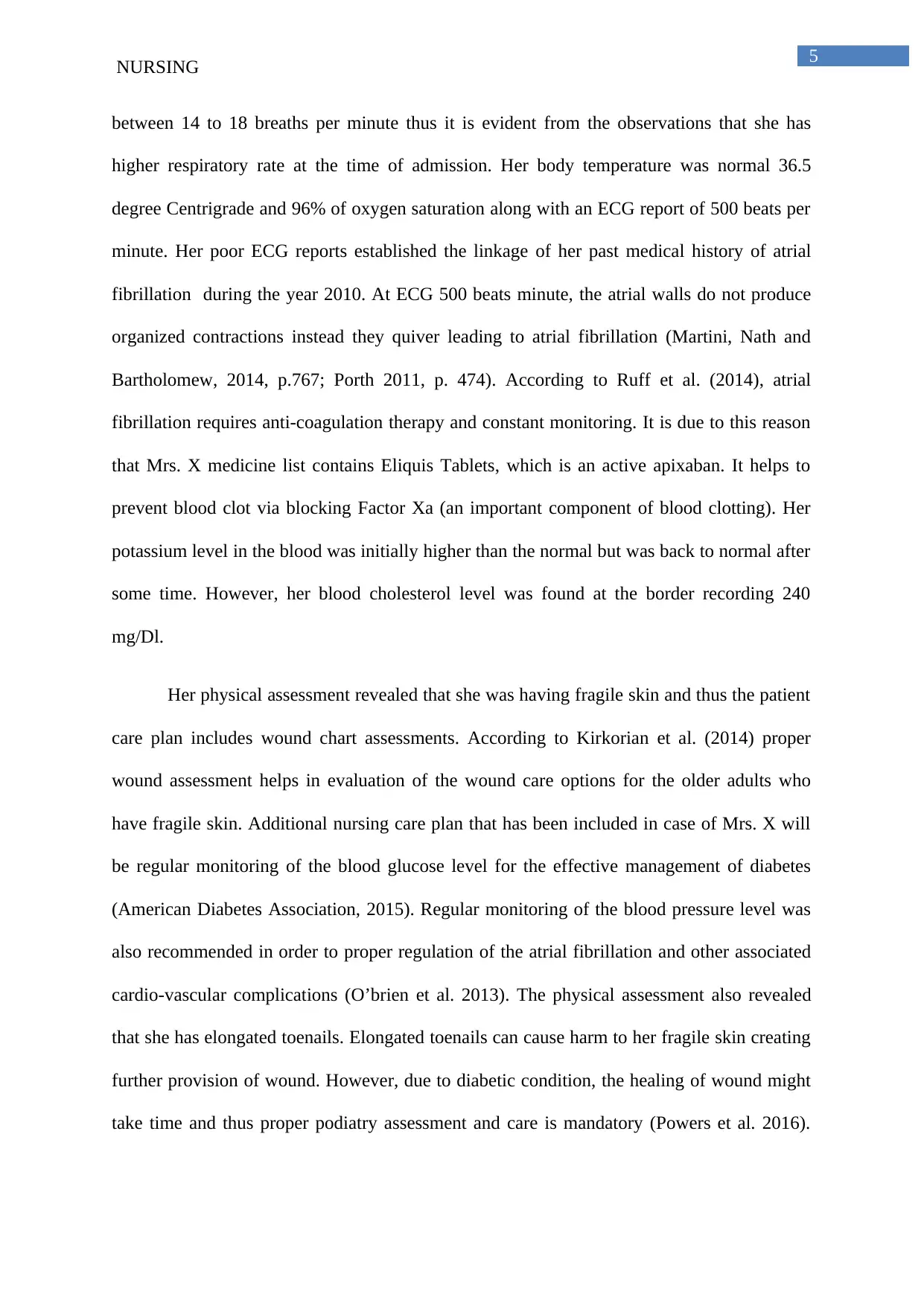
5
NURSING
between 14 to 18 breaths per minute thus it is evident from the observations that she has
higher respiratory rate at the time of admission. Her body temperature was normal 36.5
degree Centrigrade and 96% of oxygen saturation along with an ECG report of 500 beats per
minute. Her poor ECG reports established the linkage of her past medical history of atrial
fibrillation during the year 2010. At ECG 500 beats minute, the atrial walls do not produce
organized contractions instead they quiver leading to atrial fibrillation (Martini, Nath and
Bartholomew, 2014, p.767; Porth 2011, p. 474). According to Ruff et al. (2014), atrial
fibrillation requires anti-coagulation therapy and constant monitoring. It is due to this reason
that Mrs. X medicine list contains Eliquis Tablets, which is an active apixaban. It helps to
prevent blood clot via blocking Factor Xa (an important component of blood clotting). Her
potassium level in the blood was initially higher than the normal but was back to normal after
some time. However, her blood cholesterol level was found at the border recording 240
mg/Dl.
Her physical assessment revealed that she was having fragile skin and thus the patient
care plan includes wound chart assessments. According to Kirkorian et al. (2014) proper
wound assessment helps in evaluation of the wound care options for the older adults who
have fragile skin. Additional nursing care plan that has been included in case of Mrs. X will
be regular monitoring of the blood glucose level for the effective management of diabetes
(American Diabetes Association, 2015). Regular monitoring of the blood pressure level was
also recommended in order to proper regulation of the atrial fibrillation and other associated
cardio-vascular complications (O’brien et al. 2013). The physical assessment also revealed
that she has elongated toenails. Elongated toenails can cause harm to her fragile skin creating
further provision of wound. However, due to diabetic condition, the healing of wound might
take time and thus proper podiatry assessment and care is mandatory (Powers et al. 2016).
NURSING
between 14 to 18 breaths per minute thus it is evident from the observations that she has
higher respiratory rate at the time of admission. Her body temperature was normal 36.5
degree Centrigrade and 96% of oxygen saturation along with an ECG report of 500 beats per
minute. Her poor ECG reports established the linkage of her past medical history of atrial
fibrillation during the year 2010. At ECG 500 beats minute, the atrial walls do not produce
organized contractions instead they quiver leading to atrial fibrillation (Martini, Nath and
Bartholomew, 2014, p.767; Porth 2011, p. 474). According to Ruff et al. (2014), atrial
fibrillation requires anti-coagulation therapy and constant monitoring. It is due to this reason
that Mrs. X medicine list contains Eliquis Tablets, which is an active apixaban. It helps to
prevent blood clot via blocking Factor Xa (an important component of blood clotting). Her
potassium level in the blood was initially higher than the normal but was back to normal after
some time. However, her blood cholesterol level was found at the border recording 240
mg/Dl.
Her physical assessment revealed that she was having fragile skin and thus the patient
care plan includes wound chart assessments. According to Kirkorian et al. (2014) proper
wound assessment helps in evaluation of the wound care options for the older adults who
have fragile skin. Additional nursing care plan that has been included in case of Mrs. X will
be regular monitoring of the blood glucose level for the effective management of diabetes
(American Diabetes Association, 2015). Regular monitoring of the blood pressure level was
also recommended in order to proper regulation of the atrial fibrillation and other associated
cardio-vascular complications (O’brien et al. 2013). The physical assessment also revealed
that she has elongated toenails. Elongated toenails can cause harm to her fragile skin creating
further provision of wound. However, due to diabetic condition, the healing of wound might
take time and thus proper podiatry assessment and care is mandatory (Powers et al. 2016).

6
NURSING
Podiatry management will help Mrs. X to take proper care of her wound as she was unable to
do the same due to lack of proper eye-sight and gait related problems.
Thus the observation revealed that major risk factor for Mrs. X is apart from her
increase in the tendency of fall is proper monitoring and treatment for cardio-vascular
complications like atrial fibrillation, proper management of the blood glucose level in order
to control diabetes and effective podiatry management to maintain basic hygienic regulations.
Moreover, her fragile skin also demands immediate concern.
Recommendation
The recommendation for Mrs. X mainly included proper exercise and balanced diet.
Rigorous physical exercise might not be an option for Mrs. X taking her age and health into
consideration but regular physical activity at a mild to moderate level will help to reduce the
chances of unwanted fall (Giné-Garriga et al. 2014). Special tai chai exercise can further help
to increase her muscle agility and reducing the tendency of fall as reported by the study
conducted by Tousignant et al. (2013) in frail older adults. A physiotherapist will also help to
promote the muscle agility of Mrs. X (Ambrose, Paul and Hausdorff 2013). The interiors of
the room must be spacious, with less use of furniture and slip resistant floor in order to reduce
the fall rates further (Ambrose, Paul and Hausdorff 2013). Maintenance of proper diet will
help to regulate her blood glucose level and thereby helping to control diabetes. This proper
management of diet (loss salt and no sugar) can be undertaken under the effective monitoring
of a professional dietician. The dietician will help to frame a cyclic diet, which will be rich in
nutrients and thereby helping to break to monotony (American Diabetes Association 2015).
In order reduce the chances of fall further use of 4ww is mandatory. Since she also suffers
from vision loss, 4ww will promote independent movement along with reduction in the fall
rates and injuries (Ambrose, Paul and Hausdorff 2013). In order to cope up with her
NURSING
Podiatry management will help Mrs. X to take proper care of her wound as she was unable to
do the same due to lack of proper eye-sight and gait related problems.
Thus the observation revealed that major risk factor for Mrs. X is apart from her
increase in the tendency of fall is proper monitoring and treatment for cardio-vascular
complications like atrial fibrillation, proper management of the blood glucose level in order
to control diabetes and effective podiatry management to maintain basic hygienic regulations.
Moreover, her fragile skin also demands immediate concern.
Recommendation
The recommendation for Mrs. X mainly included proper exercise and balanced diet.
Rigorous physical exercise might not be an option for Mrs. X taking her age and health into
consideration but regular physical activity at a mild to moderate level will help to reduce the
chances of unwanted fall (Giné-Garriga et al. 2014). Special tai chai exercise can further help
to increase her muscle agility and reducing the tendency of fall as reported by the study
conducted by Tousignant et al. (2013) in frail older adults. A physiotherapist will also help to
promote the muscle agility of Mrs. X (Ambrose, Paul and Hausdorff 2013). The interiors of
the room must be spacious, with less use of furniture and slip resistant floor in order to reduce
the fall rates further (Ambrose, Paul and Hausdorff 2013). Maintenance of proper diet will
help to regulate her blood glucose level and thereby helping to control diabetes. This proper
management of diet (loss salt and no sugar) can be undertaken under the effective monitoring
of a professional dietician. The dietician will help to frame a cyclic diet, which will be rich in
nutrients and thereby helping to break to monotony (American Diabetes Association 2015).
In order reduce the chances of fall further use of 4ww is mandatory. Since she also suffers
from vision loss, 4ww will promote independent movement along with reduction in the fall
rates and injuries (Ambrose, Paul and Hausdorff 2013). In order to cope up with her
Paraphrase This Document
Need a fresh take? Get an instant paraphrase of this document with our AI Paraphraser

7
NURSING
elongated toenails, use of right shoes in top-toe shape and regular cutting of nails by direct
carers will be helpful along with the use of emollient cream. Proper mental health counseling
will help her to recover from depression and anxiety. Moreover, it will be the duty of the
nurse to indulge in effective communication with Mrs. X. This will help to occupy her mind
and stay away from depressive thoughts (DiCenso, Guyatt and Ciliska 2014, pp: 102-105).
Reflection on PEPF feedback
The reflection provided by my PEP facilitator was very encouraging and had a
positive attitude. My PEP helped me to get a clear idea regarding what to do. My facilitators
praised me for my skills of effective engagement to learn new things and thereby building up
therapeutic relationship. My PEP also highlighted that I need to work on my communication
skills in order to overcome my introvert nature. My facilitator also instructor me to use proper
evidence based approach while devising care plan for the patient and this goes in accordance
with the finding of DiCenso, Guyatt and Ciliska (2014, pp: 37-40).
This placement was a great experience and it will help to refine my professional
career further as a registered nurse. Proper knowledge about by professional responsibilities
will help in my practice. The self-reflection and self-evaluation also helped me work on my
drawbacks. According to Asselin and Fain (2013) self-reflection is a better way to work
critically of the drawbacks. A nurse is required to practice in a reflective mode, and Nursing
and Midwifery Board of Australia (2016) further propose this concept.
NURSING
elongated toenails, use of right shoes in top-toe shape and regular cutting of nails by direct
carers will be helpful along with the use of emollient cream. Proper mental health counseling
will help her to recover from depression and anxiety. Moreover, it will be the duty of the
nurse to indulge in effective communication with Mrs. X. This will help to occupy her mind
and stay away from depressive thoughts (DiCenso, Guyatt and Ciliska 2014, pp: 102-105).
Reflection on PEPF feedback
The reflection provided by my PEP facilitator was very encouraging and had a
positive attitude. My PEP helped me to get a clear idea regarding what to do. My facilitators
praised me for my skills of effective engagement to learn new things and thereby building up
therapeutic relationship. My PEP also highlighted that I need to work on my communication
skills in order to overcome my introvert nature. My facilitator also instructor me to use proper
evidence based approach while devising care plan for the patient and this goes in accordance
with the finding of DiCenso, Guyatt and Ciliska (2014, pp: 37-40).
This placement was a great experience and it will help to refine my professional
career further as a registered nurse. Proper knowledge about by professional responsibilities
will help in my practice. The self-reflection and self-evaluation also helped me work on my
drawbacks. According to Asselin and Fain (2013) self-reflection is a better way to work
critically of the drawbacks. A nurse is required to practice in a reflective mode, and Nursing
and Midwifery Board of Australia (2016) further propose this concept.
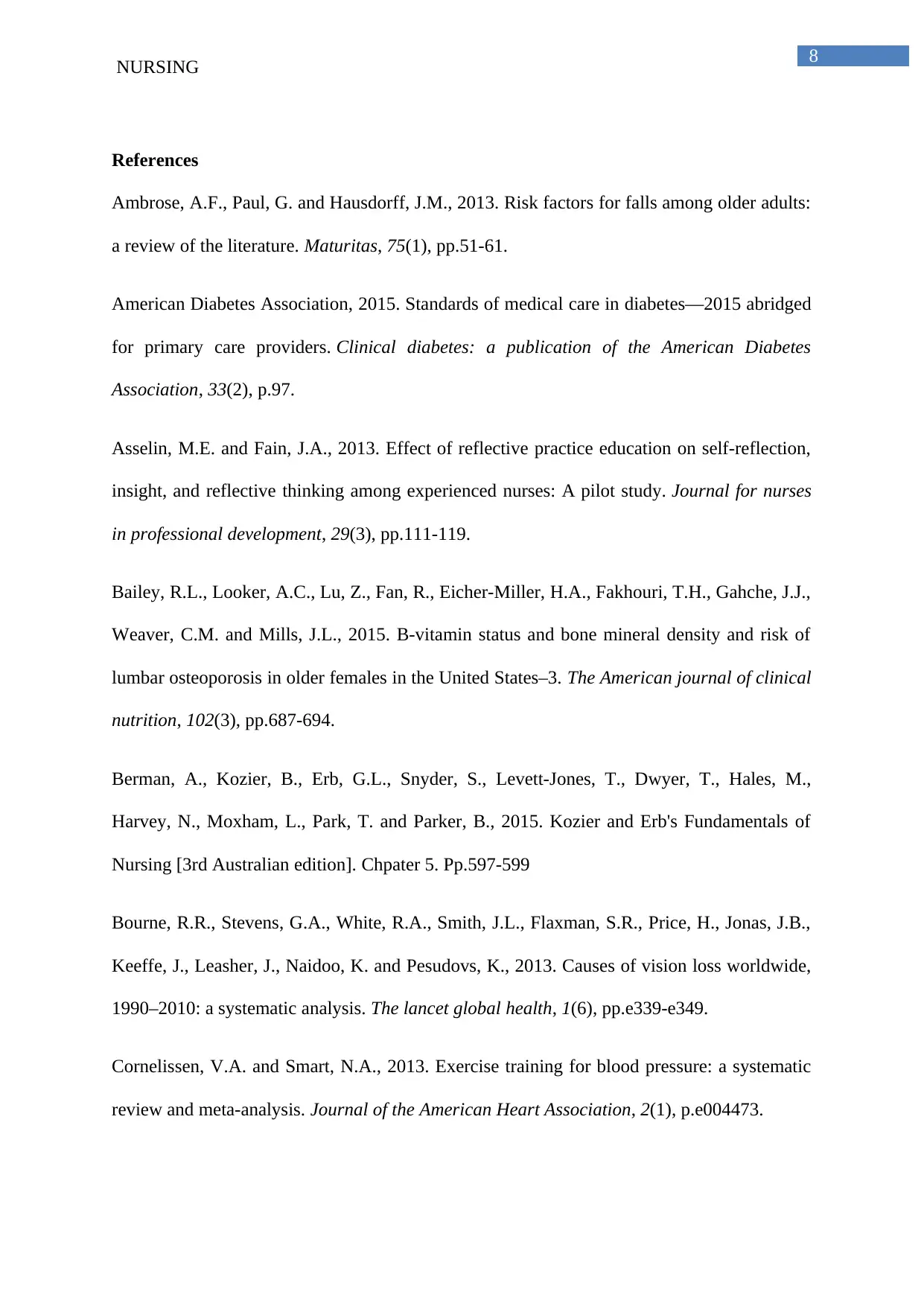
8
NURSING
References
Ambrose, A.F., Paul, G. and Hausdorff, J.M., 2013. Risk factors for falls among older adults:
a review of the literature. Maturitas, 75(1), pp.51-61.
American Diabetes Association, 2015. Standards of medical care in diabetes—2015 abridged
for primary care providers. Clinical diabetes: a publication of the American Diabetes
Association, 33(2), p.97.
Asselin, M.E. and Fain, J.A., 2013. Effect of reflective practice education on self-reflection,
insight, and reflective thinking among experienced nurses: A pilot study. Journal for nurses
in professional development, 29(3), pp.111-119.
Bailey, R.L., Looker, A.C., Lu, Z., Fan, R., Eicher-Miller, H.A., Fakhouri, T.H., Gahche, J.J.,
Weaver, C.M. and Mills, J.L., 2015. B-vitamin status and bone mineral density and risk of
lumbar osteoporosis in older females in the United States–3. The American journal of clinical
nutrition, 102(3), pp.687-694.
Berman, A., Kozier, B., Erb, G.L., Snyder, S., Levett-Jones, T., Dwyer, T., Hales, M.,
Harvey, N., Moxham, L., Park, T. and Parker, B., 2015. Kozier and Erb's Fundamentals of
Nursing [3rd Australian edition]. Chpater 5. Pp.597-599
Bourne, R.R., Stevens, G.A., White, R.A., Smith, J.L., Flaxman, S.R., Price, H., Jonas, J.B.,
Keeffe, J., Leasher, J., Naidoo, K. and Pesudovs, K., 2013. Causes of vision loss worldwide,
1990–2010: a systematic analysis. The lancet global health, 1(6), pp.e339-e349.
Cornelissen, V.A. and Smart, N.A., 2013. Exercise training for blood pressure: a systematic
review and meta‐analysis. Journal of the American Heart Association, 2(1), p.e004473.
NURSING
References
Ambrose, A.F., Paul, G. and Hausdorff, J.M., 2013. Risk factors for falls among older adults:
a review of the literature. Maturitas, 75(1), pp.51-61.
American Diabetes Association, 2015. Standards of medical care in diabetes—2015 abridged
for primary care providers. Clinical diabetes: a publication of the American Diabetes
Association, 33(2), p.97.
Asselin, M.E. and Fain, J.A., 2013. Effect of reflective practice education on self-reflection,
insight, and reflective thinking among experienced nurses: A pilot study. Journal for nurses
in professional development, 29(3), pp.111-119.
Bailey, R.L., Looker, A.C., Lu, Z., Fan, R., Eicher-Miller, H.A., Fakhouri, T.H., Gahche, J.J.,
Weaver, C.M. and Mills, J.L., 2015. B-vitamin status and bone mineral density and risk of
lumbar osteoporosis in older females in the United States–3. The American journal of clinical
nutrition, 102(3), pp.687-694.
Berman, A., Kozier, B., Erb, G.L., Snyder, S., Levett-Jones, T., Dwyer, T., Hales, M.,
Harvey, N., Moxham, L., Park, T. and Parker, B., 2015. Kozier and Erb's Fundamentals of
Nursing [3rd Australian edition]. Chpater 5. Pp.597-599
Bourne, R.R., Stevens, G.A., White, R.A., Smith, J.L., Flaxman, S.R., Price, H., Jonas, J.B.,
Keeffe, J., Leasher, J., Naidoo, K. and Pesudovs, K., 2013. Causes of vision loss worldwide,
1990–2010: a systematic analysis. The lancet global health, 1(6), pp.e339-e349.
Cornelissen, V.A. and Smart, N.A., 2013. Exercise training for blood pressure: a systematic
review and meta‐analysis. Journal of the American Heart Association, 2(1), p.e004473.
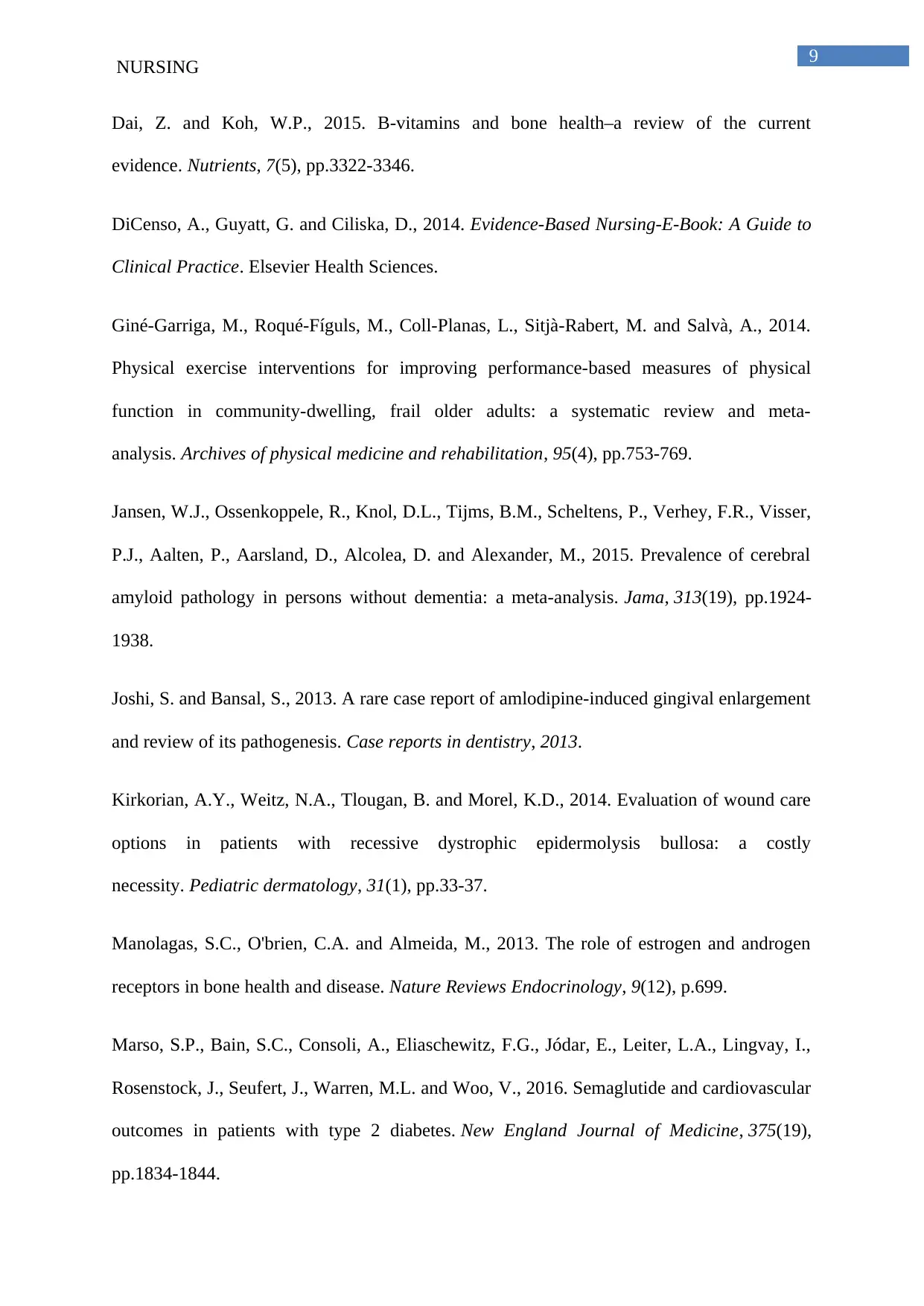
9
NURSING
Dai, Z. and Koh, W.P., 2015. B-vitamins and bone health–a review of the current
evidence. Nutrients, 7(5), pp.3322-3346.
DiCenso, A., Guyatt, G. and Ciliska, D., 2014. Evidence-Based Nursing-E-Book: A Guide to
Clinical Practice. Elsevier Health Sciences.
Giné-Garriga, M., Roqué-Fíguls, M., Coll-Planas, L., Sitjà-Rabert, M. and Salvà, A., 2014.
Physical exercise interventions for improving performance-based measures of physical
function in community-dwelling, frail older adults: a systematic review and meta-
analysis. Archives of physical medicine and rehabilitation, 95(4), pp.753-769.
Jansen, W.J., Ossenkoppele, R., Knol, D.L., Tijms, B.M., Scheltens, P., Verhey, F.R., Visser,
P.J., Aalten, P., Aarsland, D., Alcolea, D. and Alexander, M., 2015. Prevalence of cerebral
amyloid pathology in persons without dementia: a meta-analysis. Jama, 313(19), pp.1924-
1938.
Joshi, S. and Bansal, S., 2013. A rare case report of amlodipine-induced gingival enlargement
and review of its pathogenesis. Case reports in dentistry, 2013.
Kirkorian, A.Y., Weitz, N.A., Tlougan, B. and Morel, K.D., 2014. Evaluation of wound care
options in patients with recessive dystrophic epidermolysis bullosa: a costly
necessity. Pediatric dermatology, 31(1), pp.33-37.
Manolagas, S.C., O'brien, C.A. and Almeida, M., 2013. The role of estrogen and androgen
receptors in bone health and disease. Nature Reviews Endocrinology, 9(12), p.699.
Marso, S.P., Bain, S.C., Consoli, A., Eliaschewitz, F.G., Jódar, E., Leiter, L.A., Lingvay, I.,
Rosenstock, J., Seufert, J., Warren, M.L. and Woo, V., 2016. Semaglutide and cardiovascular
outcomes in patients with type 2 diabetes. New England Journal of Medicine, 375(19),
pp.1834-1844.
NURSING
Dai, Z. and Koh, W.P., 2015. B-vitamins and bone health–a review of the current
evidence. Nutrients, 7(5), pp.3322-3346.
DiCenso, A., Guyatt, G. and Ciliska, D., 2014. Evidence-Based Nursing-E-Book: A Guide to
Clinical Practice. Elsevier Health Sciences.
Giné-Garriga, M., Roqué-Fíguls, M., Coll-Planas, L., Sitjà-Rabert, M. and Salvà, A., 2014.
Physical exercise interventions for improving performance-based measures of physical
function in community-dwelling, frail older adults: a systematic review and meta-
analysis. Archives of physical medicine and rehabilitation, 95(4), pp.753-769.
Jansen, W.J., Ossenkoppele, R., Knol, D.L., Tijms, B.M., Scheltens, P., Verhey, F.R., Visser,
P.J., Aalten, P., Aarsland, D., Alcolea, D. and Alexander, M., 2015. Prevalence of cerebral
amyloid pathology in persons without dementia: a meta-analysis. Jama, 313(19), pp.1924-
1938.
Joshi, S. and Bansal, S., 2013. A rare case report of amlodipine-induced gingival enlargement
and review of its pathogenesis. Case reports in dentistry, 2013.
Kirkorian, A.Y., Weitz, N.A., Tlougan, B. and Morel, K.D., 2014. Evaluation of wound care
options in patients with recessive dystrophic epidermolysis bullosa: a costly
necessity. Pediatric dermatology, 31(1), pp.33-37.
Manolagas, S.C., O'brien, C.A. and Almeida, M., 2013. The role of estrogen and androgen
receptors in bone health and disease. Nature Reviews Endocrinology, 9(12), p.699.
Marso, S.P., Bain, S.C., Consoli, A., Eliaschewitz, F.G., Jódar, E., Leiter, L.A., Lingvay, I.,
Rosenstock, J., Seufert, J., Warren, M.L. and Woo, V., 2016. Semaglutide and cardiovascular
outcomes in patients with type 2 diabetes. New England Journal of Medicine, 375(19),
pp.1834-1844.
Secure Best Marks with AI Grader
Need help grading? Try our AI Grader for instant feedback on your assignments.
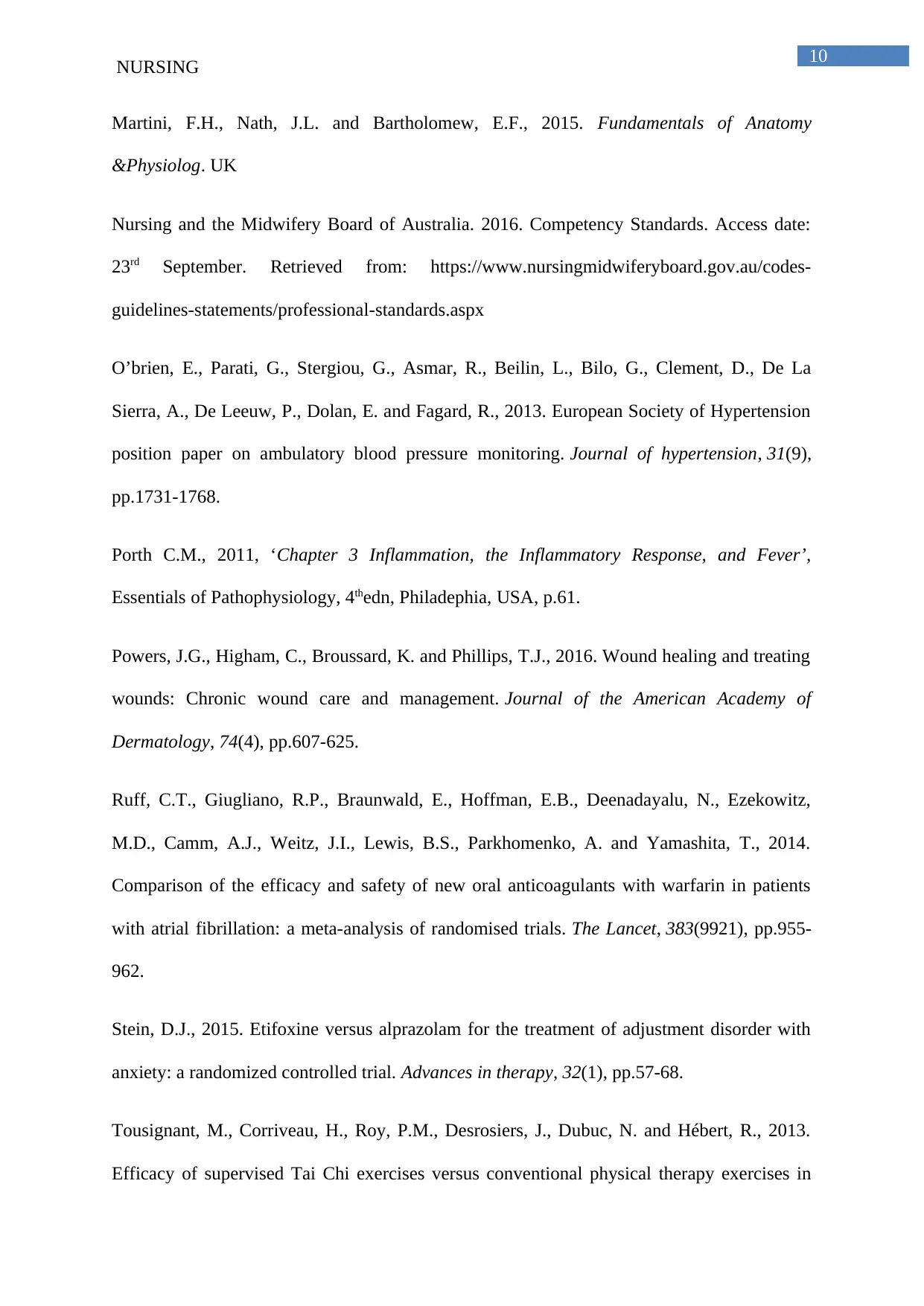
10
NURSING
Martini, F.H., Nath, J.L. and Bartholomew, E.F., 2015. Fundamentals of Anatomy
&Physiolog. UK
Nursing and the Midwifery Board of Australia. 2016. Competency Standards. Access date:
23rd September. Retrieved from: https://www.nursingmidwiferyboard.gov.au/codes-
guidelines-statements/professional-standards.aspx
O’brien, E., Parati, G., Stergiou, G., Asmar, R., Beilin, L., Bilo, G., Clement, D., De La
Sierra, A., De Leeuw, P., Dolan, E. and Fagard, R., 2013. European Society of Hypertension
position paper on ambulatory blood pressure monitoring. Journal of hypertension, 31(9),
pp.1731-1768.
Porth C.M., 2011, ‘Chapter 3 Inflammation, the Inflammatory Response, and Fever’,
Essentials of Pathophysiology, 4thedn, Philadephia, USA, p.61.
Powers, J.G., Higham, C., Broussard, K. and Phillips, T.J., 2016. Wound healing and treating
wounds: Chronic wound care and management. Journal of the American Academy of
Dermatology, 74(4), pp.607-625.
Ruff, C.T., Giugliano, R.P., Braunwald, E., Hoffman, E.B., Deenadayalu, N., Ezekowitz,
M.D., Camm, A.J., Weitz, J.I., Lewis, B.S., Parkhomenko, A. and Yamashita, T., 2014.
Comparison of the efficacy and safety of new oral anticoagulants with warfarin in patients
with atrial fibrillation: a meta-analysis of randomised trials. The Lancet, 383(9921), pp.955-
962.
Stein, D.J., 2015. Etifoxine versus alprazolam for the treatment of adjustment disorder with
anxiety: a randomized controlled trial. Advances in therapy, 32(1), pp.57-68.
Tousignant, M., Corriveau, H., Roy, P.M., Desrosiers, J., Dubuc, N. and Hébert, R., 2013.
Efficacy of supervised Tai Chi exercises versus conventional physical therapy exercises in
NURSING
Martini, F.H., Nath, J.L. and Bartholomew, E.F., 2015. Fundamentals of Anatomy
&Physiolog. UK
Nursing and the Midwifery Board of Australia. 2016. Competency Standards. Access date:
23rd September. Retrieved from: https://www.nursingmidwiferyboard.gov.au/codes-
guidelines-statements/professional-standards.aspx
O’brien, E., Parati, G., Stergiou, G., Asmar, R., Beilin, L., Bilo, G., Clement, D., De La
Sierra, A., De Leeuw, P., Dolan, E. and Fagard, R., 2013. European Society of Hypertension
position paper on ambulatory blood pressure monitoring. Journal of hypertension, 31(9),
pp.1731-1768.
Porth C.M., 2011, ‘Chapter 3 Inflammation, the Inflammatory Response, and Fever’,
Essentials of Pathophysiology, 4thedn, Philadephia, USA, p.61.
Powers, J.G., Higham, C., Broussard, K. and Phillips, T.J., 2016. Wound healing and treating
wounds: Chronic wound care and management. Journal of the American Academy of
Dermatology, 74(4), pp.607-625.
Ruff, C.T., Giugliano, R.P., Braunwald, E., Hoffman, E.B., Deenadayalu, N., Ezekowitz,
M.D., Camm, A.J., Weitz, J.I., Lewis, B.S., Parkhomenko, A. and Yamashita, T., 2014.
Comparison of the efficacy and safety of new oral anticoagulants with warfarin in patients
with atrial fibrillation: a meta-analysis of randomised trials. The Lancet, 383(9921), pp.955-
962.
Stein, D.J., 2015. Etifoxine versus alprazolam for the treatment of adjustment disorder with
anxiety: a randomized controlled trial. Advances in therapy, 32(1), pp.57-68.
Tousignant, M., Corriveau, H., Roy, P.M., Desrosiers, J., Dubuc, N. and Hébert, R., 2013.
Efficacy of supervised Tai Chi exercises versus conventional physical therapy exercises in
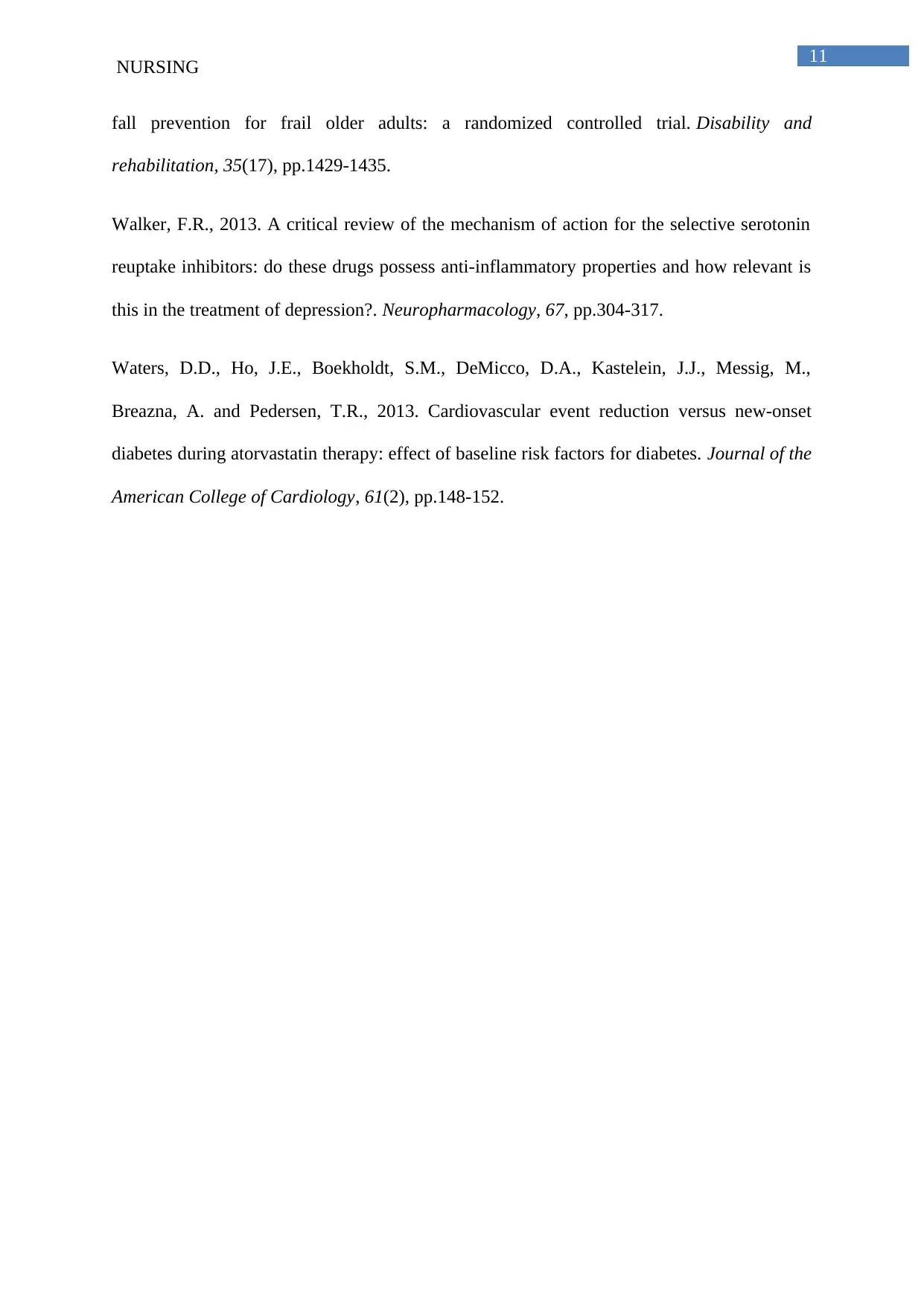
11
NURSING
fall prevention for frail older adults: a randomized controlled trial. Disability and
rehabilitation, 35(17), pp.1429-1435.
Walker, F.R., 2013. A critical review of the mechanism of action for the selective serotonin
reuptake inhibitors: do these drugs possess anti-inflammatory properties and how relevant is
this in the treatment of depression?. Neuropharmacology, 67, pp.304-317.
Waters, D.D., Ho, J.E., Boekholdt, S.M., DeMicco, D.A., Kastelein, J.J., Messig, M.,
Breazna, A. and Pedersen, T.R., 2013. Cardiovascular event reduction versus new-onset
diabetes during atorvastatin therapy: effect of baseline risk factors for diabetes. Journal of the
American College of Cardiology, 61(2), pp.148-152.
NURSING
fall prevention for frail older adults: a randomized controlled trial. Disability and
rehabilitation, 35(17), pp.1429-1435.
Walker, F.R., 2013. A critical review of the mechanism of action for the selective serotonin
reuptake inhibitors: do these drugs possess anti-inflammatory properties and how relevant is
this in the treatment of depression?. Neuropharmacology, 67, pp.304-317.
Waters, D.D., Ho, J.E., Boekholdt, S.M., DeMicco, D.A., Kastelein, J.J., Messig, M.,
Breazna, A. and Pedersen, T.R., 2013. Cardiovascular event reduction versus new-onset
diabetes during atorvastatin therapy: effect of baseline risk factors for diabetes. Journal of the
American College of Cardiology, 61(2), pp.148-152.
1 out of 12
Related Documents
Your All-in-One AI-Powered Toolkit for Academic Success.
+13062052269
info@desklib.com
Available 24*7 on WhatsApp / Email
![[object Object]](/_next/static/media/star-bottom.7253800d.svg)
Unlock your academic potential
© 2024 | Zucol Services PVT LTD | All rights reserved.





